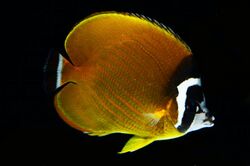Biology:Chaetodon wiebeli
| Chaetodon wiebeli | |
|---|---|

| |
| Scientific classification | |
| Domain: | Eukaryota |
| Kingdom: | Animalia |
| Phylum: | Chordata |
| Class: | Actinopterygii |
| Order: | Perciformes |
| Family: | Chaetodontidae |
| Genus: | Chaetodon |
| Subgenus: | Chaetodon (Rabdophorus) |
| Species: | C. wiebeli
|
| Binomial name | |
| Chaetodon wiebeli Kaup, 1863
| |
| Synonyms[2] | |
| |
Chaetodon wiebeli, commonly known as the Hong Kong butterflyfish, Wiebel's butterflyfish or blackcap butterflyfish, is a species of marine ray-finned fish, a butterflyfish belonging to the family Chaetodontidae. It is native to the Western Pacific Ocean.
Description
Chaetodon wiebeli has an oval shaped, deep and strongly compressed body with a head which is the same height as its width and a short snout with a small protractile mouth equipped with setiform teeth in its jaws.[3] These teeth are referred to in the genus name Chaetodon which means "bristle tooth".[4] It has a smooth preopercle which does not have any obvious spines.[3] The colouration is mainly yellow marked with oblique brown lines. There is a vertical black band running through the eye, with a white bar to its rear, and a black blotch on the forehead. The dorsal, anal, pelvic and caudal fins are yellow, although the caudal fin has a black margin.[5] The dorsal fin contains a total of 12–13 spines and 22–25 soft rays while the anal fin has 3 spines and 18–20 soft rays. This species attains a maximum total length of 19 centimetres (7.5 in).[2]
Distribution
Chaetodon wiebeli is found in the western Pacific Ocean from southern Japan and South Korea to northern Java, extending into the Gulf of Thailand.[1]
Habitat and biology
Chaetodon wiebeli is found in both rocky and coral reefs, where they are normally encountered in pairs and in small shoals.[2] They feed on coral polyps, benthic invertebrates and algae.[5] This is an oviparous species which forms pairs during breeding.[2] They may be solitary and their main feeding technique is grazing algae off rocks.[1] They can ben found at depths of 4 to 25 metres (13 to 82 ft).[3]
Systematics
Chaetodon wiebeli was first formally described in 1863 by the German ichthyologist Johann Jakob Kaup (1803–1873) with the type locality given as Canton in China.[6] The specific name honours Kaup's friend, the naturalist and one of the founders of the Zoological Museum in Hamburg, Karl Maximilian Wiebel (1808–1888).[4] It belongs to the large subgenus Rabdophorus which might warrant recognition as a distinct genus.[7]
References
- ↑ 1.0 1.1 1.2 Myers, R.F.; Pratchett, M. (2010). "Chaetodon wiebeli". IUCN Red List of Threatened Species 2010: e.T165685A6091062. doi:10.2305/IUCN.UK.2010-4.RLTS.T165685A6091062.en. https://www.iucnredlist.org/species/165685/6091062. Retrieved 20 November 2021.
- ↑ 2.0 2.1 2.2 2.3 Froese, Rainer and Pauly, Daniel, eds. (2019). "Chaetodon weibeli" in FishBase. December 2019 version.
- ↑ 3.0 3.1 3.2 "Chaetodon weibeli". https://fishdb.sinica.edu.tw/eng/species.php?gen=Chaetodon&spe=wiebeli. Retrieved 29 December 2020.
- ↑ 4.0 4.1 "Order ACANTHURIFORMES (part 1): Families LOBOTIDAE, POMACANTHIDAE, DREPANEIDAE and CHAETODONTIDAE". The ETYFish Project Fish Name Etymology Database. Christopher Scharpf and Kenneth J. Lazara. 21 July 2020. http://www.etyfish.org/acanthuriformes1/. Retrieved 29 December 2020.
- ↑ 5.0 5.1 "Chaetodon weibeli". Saltcorner. Bob Goemans. 2012. http://www.saltcorner.com/AquariumLibrary/browsespecies.php?CritterID=547&filter=0. Retrieved 29 December 2020.
- ↑ Eschmeyer, William N.; Fricke, Ron; van der Laan, Richard, eds. "Species in the genus Chaetodon". California Academy of Sciences. http://researcharchive.calacademy.org/research/ichthyology/catalog/fishcatget.asp?tbl=species&genus=Chaetodon.
- ↑ Fessler, Jennifer L.; Westneat, Mark W (2007). "Molecular phylogenetics of the butterflyfishes (Chaetodontidae): Taxonomy and biogeography of a global coral reef fish family". Molecular Phylogenetics and Evolution 45 (1): 50–68. doi:10.1016/j.ympev.2007.05.018.
Wikidata ☰ Q2947554 entry
 |


